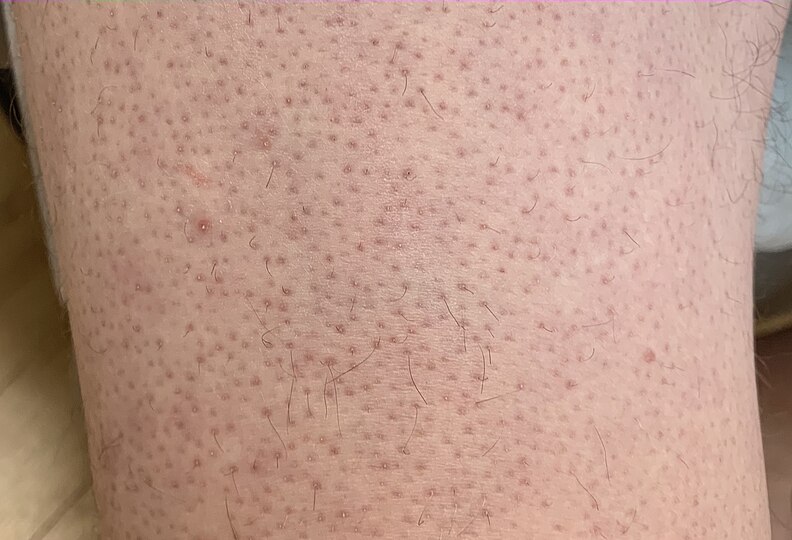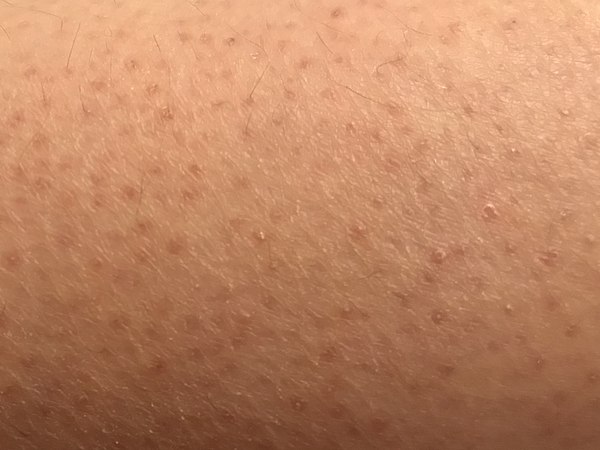Keratosis Pilaris, often abbreviated as KP, is a common and harmless skin condition that affects millions of people worldwide. Characterized by small, rough bumps on the skin, this condition is frequently mistaken for acne or goosebumps. While it may not pose any serious health risks, Keratosis Pilaris can cause discomfort and self-consciousness for those who experience it. In this article, we will explore what Keratosis Pilaris is, its underlying causes, common symptoms, and effective treatment options to manage the condition.

What Is Keratosis Pilaris?
Keratosis Pilaris is a skin condition that occurs when keratin, a protein found in the skin, hair, and nails, builds up and clogs hair follicles. This buildup creates tiny, raised bumps on the surface of the skin, giving it a texture similar to sandpaper. The condition most commonly appears on the upper arms, thighs, cheeks, and buttocks, though it can occur anywhere on the body where hair follicles are present.
While Keratosis Pilaris is not harmful, it can be persistent and difficult to treat completely. The good news is that the appearance of the bumps can often be improved with proper care and treatment. Understanding the nature of this condition is the first step toward managing it effectively.
Causes of Keratosis Pilaris
The exact cause of Keratosis Pilaris is not fully understood, but researchers believe it is linked to genetics and an overproduction of keratin. Below are some of the key factors that contribute to the development of this condition:
1. Excess Keratin Production
- Keratin is a protective protein that helps shield the skin from infections and other harmful substances. However, in individuals with Keratosis Pilaris, the body produces too much keratin, leading to blockages in the hair follicles.
- This excess keratin forms hard plugs that trap hair beneath the skin’s surface, resulting in the characteristic bumps associated with the condition.
2. Genetic Predisposition
- Keratosis Pilaris often runs in families, suggesting a genetic component. If one or both parents have the condition, their children are more likely to develop it as well.
- Research indicates that certain genetic mutations may affect how the skin produces and processes keratin, contributing to the development of Keratosis Pilaris.
3. Dry Skin
- Dry skin is a common trigger for Keratosis Pilaris. When the skin lacks moisture, it becomes more prone to irritation and inflammation, which can exacerbate the condition.
- People with naturally dry skin or those living in cold, dry climates may experience more severe symptoms.
4. Hormonal Changes
- Hormonal fluctuations, particularly during puberty, pregnancy, or menopause, can influence the skin’s production of keratin and oil. These changes may worsen Keratosis Pilaris or cause it to appear for the first time.
- Teenagers and young adults are more likely to experience the condition due to hormonal shifts during these stages of life.
Symptoms of Keratosis Pilaris
The symptoms of Keratosis Pilaris are generally mild and do not cause significant discomfort. However, they can vary in severity depending on the individual. Here are the most common signs and symptoms associated with the condition:
1. Small, Raised Bumps
- The hallmark symptom of Keratosis Pilaris is the presence of small, flesh-colored or slightly red bumps on the skin. These bumps are typically painless but may feel rough to the touch.
- In some cases, the bumps may appear white or resemble tiny pimples.
2. Rough, Sandpaper-Like Texture
- Affected areas of the skin often feel dry and rough, similar to sandpaper. This texture is most noticeable on the upper arms, thighs, and cheeks.
- The roughness may become more pronounced during colder months or in low-humidity environments.
3. Redness and Inflammation
- In individuals with fair skin, the bumps may be accompanied by mild redness or inflammation around the affected follicles.
- For those with darker skin tones, the redness may be less visible, but the bumps can still cause discoloration or hyperpigmentation.
4. Seasonal Flare-Ups
- Keratosis Pilaris tends to worsen during the winter months when the air is drier and humidity levels are lower. Conversely, symptoms may improve in the summer due to increased moisture in the air.
- Using harsh soaps or taking long, hot showers can also trigger flare-ups by stripping the skin of its natural oils.
Treatment Options for Keratosis Pilaris
While there is no permanent cure for Keratosis Pilaris, several treatment options can help reduce its appearance and improve the texture of the skin. These treatments focus on exfoliating the skin, moisturizing, and preventing further blockages in the hair follicles. Below are some of the most effective strategies for managing the condition:
1. Regular Exfoliation
- Gentle exfoliation can help remove dead skin cells and prevent keratin from building up in the hair follicles. Use a soft washcloth, loofah, or exfoliating scrub to cleanse the affected areas.
- Chemical exfoliants containing alpha hydroxy acids (such as glycolic acid) or beta hydroxy acids (such as salicylic acid) are particularly effective for treating Keratosis Pilaris. These ingredients penetrate the skin deeply to dissolve keratin plugs.
2. Moisturizing
- Keeping the skin hydrated is essential for managing Keratosis Pilaris. Apply a rich, fragrance-free moisturizer immediately after bathing to lock in moisture and soften the skin.
- Look for moisturizers that contain ingredients like urea, lactic acid, or ceramides, as these can help exfoliate and repair the skin barrier.
3. Topical Treatments
- Over-the-counter creams and lotions containing retinoids or vitamin A derivatives can promote cell turnover and prevent clogged follicles. These products should be used sparingly to avoid irritation.
- For more severe cases, a dermatologist may prescribe stronger topical treatments, such as prescription-strength retinoids or corticosteroid creams, to reduce inflammation and improve the skin’s appearance.
4. Lifestyle Adjustments
- Avoid using harsh soaps or cleansers that can strip the skin of its natural oils. Opt for gentle, non-foaming cleansers instead.
- Limit exposure to hot water, as it can dry out the skin and worsen symptoms. Take shorter showers and use lukewarm water whenever possible.
- Incorporate a humidifier into your home environment, especially during the winter months, to maintain optimal humidity levels and prevent dryness.
5. Professional Treatments
- In-office procedures, such as chemical peels, microdermabrasion, or laser therapy, may be recommended for individuals with persistent or severe Keratosis Pilaris. These treatments work by removing the outer layer of dead skin cells and stimulating collagen production.
- Consult a dermatologist to determine whether professional treatments are appropriate for your specific case.
Preventing Keratosis Pilaris Flare-Ups
While Keratosis Pilaris cannot be prevented entirely, adopting a consistent skincare routine can help minimize flare-ups and keep the skin looking healthy. Here are some tips to prevent the condition from worsening:
- Use gentle, non-comedogenic skincare products that do not clog pores.
- Apply sunscreen daily to protect the skin from UV damage, which can exacerbate dryness and irritation.
- Stay hydrated by drinking plenty of water throughout the day.
- Eat a balanced diet rich in vitamins and minerals that support skin health, such as omega-3 fatty acids and antioxidants.
When to See a Dermatologist
If over-the-counter treatments and lifestyle changes fail to improve your symptoms, or if you experience significant discomfort or emotional distress due to Keratosis Pilaris, it may be time to consult a dermatologist. A dermatologist can provide personalized recommendations and advanced treatment options tailored to your needs.
Additionally, seek medical advice if you notice any unusual changes in your skin, such as persistent redness, swelling, or signs of infection. These could indicate an underlying issue that requires prompt attention.





